CHIRPINGS - Forest and Bird
←
→
Page content transcription
If your browser does not render page correctly, please read the page content below
CHIRPINGS
The e-magazine of the Wellington Branch of Forest & Bird
Edition 8: Jan 2019
Branch by Mike Britton, Chair, Wellington Branch
news
I was recently told off for being pessimistic about the year ahead. It
was politics in the US and Brazil that had coloured my outlook. It was
pointed out to me that good things were happening like the number of
women in the US House of Representatives and the numbers voting,
all of which heralded positive change.
Forest & Bird as nature’s advocate is going from strength to strength
and making real progress, and our branch is doing its share. The start
of Wild Wednesday evenings is a chance for members to get together and focus on nature in our
city and beyond. As advertised in this edition the first will be on ‘Capital Kiwis’ at Forest & Bird on
Wednesday 13 February. Another real positive is the
Forest & Bird Youth, with an active chapter in the
Wellington region.
For me personally seeing all the activity at Zealandia is
uplifting. A takahē chick is a first and it’s growing fast. All
being well it will soon be able to be seen by visitors.
Tuatara are active and visible; hard to remember that only
a few years ago you could only see them on a very few
offshore islands. And the 1000th hihi chick has just been Hihi with leg bands
banded. This all emphasizes that while Zealandia is a great
place to visit, there is serious conservation going on, and it’s all part of national recovery plans.
And, while not indigenous, the Zealandia prize for cuteness goes to a family of California quail! So,
with summer sun and surrounded by nature, my message is ‘let’s be inspired to be agents of action
and change’.
Local news
A bad summer for cuckoos
Pīpīwharauroa, shining cuckoos, are one of the few land birds that migrate to New Zealand for the
summer. They arrive in September – October each year from their wintering grounds in the tropics.
They are rarely seen due to their small size and cryptic plumage, but they are known to many by
their call — a series of rising whistles finished by one or two descending notes, which can be heard
for hundreds of metres, and also for flying into glass windows
and doors.
This summer there seem to be fewer shining cuckoos
nationally and this has been noticeable in the Wellington
region. Reports also suggest that shining cuckoos appear to
have arrived later this year. This could be due to food
shortages in their wintering areas, or possibly due to
something that has disrupted their migration such as adverse
This one committed fenestricide weather. It will be interesting to see how long it takes for
Photo: Orde family numbers to return to normal.
1On 20 December, the ‘Stuff’ website reported that a koekoeā, long-tailed cuckoo, was killed in
Strathmore when it also flew into a window after being harassed by tūī. Long-tailed cuckoos are
extremely rare in Wellington and are normally birds of forest and scrub. It’s common for songbirds
to mob predators such as hawks, falcons and owls, but it’s interesting that tūī had the instinct to do
so, for this bird is no threat to them or their nests as it normally lays its eggs in the nests of
pōpokotea, whitehead.
Spring was wet last year which allowed many plant species to do
well early in the growth season. As a result, tī kōuka, cabbage trees,
seem to have flowered particularly well this season, pōhutukawa
flowers were spectacular in much of the region and flax in many
areas produced huge flower spikes. Consequently, nectar was
abundant, as in due course should be fruits and seeds.
Project Jonah
Over a weekend late last year, Project Jonah ran two courses on cetacean rescue. Project Jonah has
pioneered whale and dolphin rescue since 1974 and has developed methods, equipment and
techniques that have saved the lives of thousands of whales and dolphins around the New Zealand
coast. Their techniques and equipment are so innovative and successful they have been adopted in
many other parts of the world.
We’ve all seen heart wrenching scenes of dozens, even hundreds of dolphins or whales stranded,
often pilot whales on the shores of Golden Bay. Over the years, the project has trained over 3,000
people as ‘marine mammal medics’. The people who attended the recent training courses are likely
to be called on to volunteer for the next stranding at Golden Bay or in the lower North Island. The
recent Wellington courses added 40 extra people to their database.
The training day comprised a morning in
a classroom environment at the SPCA on
Mount Victoria focussing on theory, which
was run by Daren Grover and Louisa
Hawkes, the organisation’s only paid staff.
It covered a lot of information, some of
which was obvious, but other elements of
which were not at all what you might
think. This was neatly proved by asking
candidates to write down their thoughts
and impressions of a photo taken at a
whale rescue both at the start and end of
Trainees learning rescue techniques using a 2 tonne water
the session. We found we had learned
inflated pilot whale. Photo: Project Jonah sooo much in four hours!
The afternoon session was a mock rescue of a dolphin and a
pilot whale. The Project Jonah team has inflatable models about
life size which are filled with water and weigh in at about 200 kg
and 2,000 kg respectively. At Scorching Bay, where the practical
training was held, many members of the public came to ask what
was going on, and a local news crew called in on the first day
thinking the rescue was real.
Throughout the training, great emphasis was put on health &
safety, and keeping volunteer medics in good condition was top Practice rescue at Scorching Bay
Photo: Cameron Sang
2priority. Some of the things to do or not do are not at all obvious, and we learned about lifting
techniques, using a whale flotation pontoon, what parts of a whale to touch and what to avoid, and
how best to cool the whale down to prevent heat exhaustion, their biggest problem while stranded.
You can find out more at www.projectjonah.org.nz or by emailing Louisa at
louisahawkes@projectjonah.org.nz . Project Jonah is a charity and runs from donations. If unable to
assist in person, you can help by making a regular or one-off donation.
Forest & Bird programme — Places for Penguins update
The team at Places for Penguins has been doing a great job providing nestboxes and monitoring
them for occupancy and breeding success of kororā, Little Penguins, round much of the Wellington
coastline since the breeding season started last July. In
April and May 2018, things were looking very promising
with adult birds checking out the boxes and making nests
in many of them.
But something seems to have happened after that. In
Wellington, the breeding season normally starts in July, but
last year few pairs began laying eggs at that time. The birds
that had built nests disappeared and many were late
Adults checking out the accommodation coming to shore to breed. Some of the boxes with newly
built nests were never occupied at all. It’s possible that
food stocks were depleted, or that adult birds were unable to return to breed for some reason e.g.
one of the pair was killed. As the season progressed more kororā did come ashore to nest and while
results are not in yet, there seems to be a similar occupancy and success rate as recent years. Pairs
usually lay two eggs, but one is not uncommon and
three have been reported on a few occasions.
Once eggs hatch, the chicks emerge clad in short black
velvety down. While they are in this state, a parent stays
with them all the time to keep them warm, with the
adults swapping guard duty every night or two. As the
chicks grow bigger, they develop longer fluffy grey
down which has better insulation properties. This along
with their bigger size allows them to maintain their own
body temperature, and the adults are able to leave the
chicks unaccompanied during the day while they both
go fishing to feed the hungry brood. Chicks in grey down
Chicks stay in the nest for an average of 56 days and their
parents return every night to feed them. As they grow from
baby duckling size to almost a kilo in weight, they go from
lying or squatting to standing tall in the nestbox. In the last
couple of weeks of their time in the nest, adult plumage
starts to push through. The new plumage is pristine and
sometimes bluer than in adults. The chicks scratch and
preen during this period either to get their new feathers in
top condition, or maybe just because the feathering
process is rather itchy.
A ruff and bonnet of down remains. The
other chick is a bit shy.
3This leads to a stage where the birds are about adult size and have a beautiful new set of feathers,
except for the backs of the neck which they cannot reach with beak or claw, and so a patch of grey
down often stays in place until the birds are finally ready to leave the nest. At this stage the parents
have decided the kids can look after themselves and have gone back out to sea to feed themselves
up ahead of their next challenge in a couple of months’ time — moulting. The chicks are left to find
out for themselves how to swim, fish, avoid danger and other skills needed to be a successful adult
penguin. It’s a tough childhood.
NEW SECTION
FOREST & BIRD WELLINGTON’S WILD WEDNESDAYS
The Wellington branch is going to be arranging several different events that will interest members.
We’ll be publicising them a month or two ahead. There will be a mix of subject matter and some
great presenters who are experts in their field. Here are the details and dates for the first couple of
events, so mark them in your diary and come along.
Capital Kiwi — Restoring Our National Icon to the Capital City
When: Wednesday 13th February 2019, 6.30pm to 9.00pm
At: Forest & Bird Office, Ground Floor, 205 Victoria Street, Wellington
Kiwi, the feisty flightless birds with the chop-stick bill, have been absent
from Wellington for over a century, unable to survive habitat loss and the
array of predators introduced by the people who’re named after them.
Join us to hear Paul Stanley Ward (Founder and
Project Lead for Capital Kiwi) talk about Capital
Kiwi’s exciting and ambitious plan to re-introduce
kiwi to Wellington.
Wellington has become a front-running biodiversity hotspot
and this project will help cement our place as New Zealand’s
Natural Capital.
Presented by Forest & Bird Youth Wellington and Plastic Oceans
Film: A Plastic Ocean - In support of Sea Week 2019
When he discovers the world's oceans brimming with plastic waste, a
documentary filmmaker investigates the pollution's environmental
impacts. Produced by the Plastic Oceans Foundation, this film uncovers the damage being wrought
to the world’s oceans by our use of plastic. Plastic pollution is also an issue in New Zealand’s oceans
and threatens our precious marine taonga.
Given the Government's recent moves to ban single-use plastic bags, what needs to happen next?
Come and watch this movie about the state of our oceans and share your thoughts and ideas about
how we can tackle this pressing issue.
When: Wednesday 06 March 2019, 6.30pm to 9.00pm
Where: Memorial Theatre, Kelburn Campus, Victoria University of Wellington
For more information about the Plastic Oceans Foundation https://plasticoceans.org/about-film/
Or to donate https://plasticoceans.org/donate/
For more information about Forest & Bird Youth Wellington
And on the Wellington branch https://www.forestandbird.org.nz/branches/wellington
4Wellybird – a personal view
Red-billed gull
Summer is the time most people encounter tarāpunga, the red-billed gull. These beautiful birds are
occasionally seen on inland lakes or farmland, but generally they
are very much coastal gulls and are usually seen close to the
shoreline. They often congregate at the same beaches and
tourist haunts that people go to on their summer break. Strange
that gulls should choose the same holiday spots as humans – a
clue on this later.
The red bill and legs of adult
birds stand out strongly
against the pale plumage. In
young birds the bill is darker
and the legs paler. Juveniles could be confused with black billed
gulls, but the latter are rare in Wellington, and while there is a
colony in the Wairarapa, they are more birds of inland lakes and
rivers.
At rest red-billed gulls are dumpy headed and peaceful, often
roosting in groups, sometimes alongside white-fronted terns,
but they have a feisty side too. In territorial disputes they are Thinks... that looks like a chip packet
noisy and aggressive towards others such as the one at left which was ‘king of the castle’ at White
Rock on the Wairarapa coast. Disputes can be noisy affairs with
lots of posturing and loud calls to intimidate any would-be
interlopers.
Red-billed gulls are well known to beachgoers. They have
developed a liking for hot chips, sandwiches, pies and other
picnic favourites to the extent that they will steal our food
wherever the chance exists. Sit on a beachside seat with a paper
package and suddenly they
become very attentive.
However, feeding them is not to be
encouraged. Bold ones can
terrorise small children with food.
They develop a liking for foods
which are not part of their natural
diet and which may deprive them of the nutrients they should be
getting from the marine organisms that they would eat without the
intervention of fast food. Nationally, red-billed gull numbers are
dwindling, and while they may seem common at popular beaches,
they are classified variously as declining, vulnerable and threatened.
E-newsletter
Do you have any ideas for subject matter or things you’d be interested in hearing about in this
newsletter? Please let us know by email to wellington.branch@forestandbird.org.nz. Any photos
submitted must include photographer’s credit and permission to be used.
Photos by the editor unless otherwise credited
5You can also read



























































